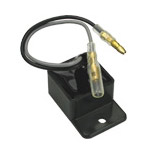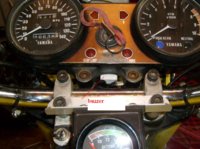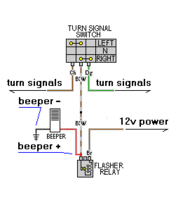Ruined1
82 Maxim xs400 Owner
Ok so I ordered and installed this all in one light kit:
http://www.kapscomoto.com/product_p/tl-gj-022-1m.htm
Of course I removed my oem tail light and rear turn signals. Now I face that same problem where my turn signals (and the respective indicator lamp) stay on when applied and do not flash. I tried adding in 1k, 10k, and 100k 1/4watt resistors to change resistance (because I had them on hand) nothing changed my issue.
I tried adding in 1k, 10k, and 100k 1/4watt resistors to change resistance (because I had them on hand) nothing changed my issue. 
For an example, the rear light turn signal has 2.88 resistance when off and zeroes out when turned on... Do I need to compensate and cause 2.88 resistance in-line for when it is turned on? Does the resistance needed get affected by all points at once ? (If I get the right turn signal to blink with appropriate resistance, will the left one too? or is it a separate application?)
? (If I get the right turn signal to blink with appropriate resistance, will the left one too? or is it a separate application?)
Any help is appreciated.
http://www.kapscomoto.com/product_p/tl-gj-022-1m.htm
Of course I removed my oem tail light and rear turn signals. Now I face that same problem where my turn signals (and the respective indicator lamp) stay on when applied and do not flash.
 I tried adding in 1k, 10k, and 100k 1/4watt resistors to change resistance (because I had them on hand) nothing changed my issue.
I tried adding in 1k, 10k, and 100k 1/4watt resistors to change resistance (because I had them on hand) nothing changed my issue. 
For an example, the rear light turn signal has 2.88 resistance when off and zeroes out when turned on... Do I need to compensate and cause 2.88 resistance in-line for when it is turned on? Does the resistance needed get affected by all points at once
Any help is appreciated.








